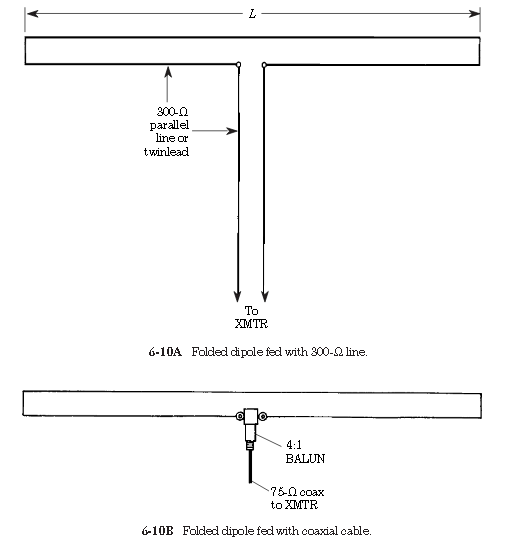One of the rarely discussed aspects of antenna construction is that the length/diame-ter ratio of the conductor used for the antenna element is a factor in determining thebandwidth of the antenna. In general, the rule of thumb states that large cross-sec-tional area makes the antenna more broadbanded. In some cases, this rule suggeststhe use of aluminum tubing instead of copper wire for the antenna radiator. On thehigher-frequency bands that is a viable solution. Aluminum tubing can be purchasedfor relatively small amounts of money, and is both lightweight and easily worked withordinary tools. But, as the frequency decreases, the weight becomes greater becausethe tubing is both longer and (for structural strength) must be of greater diameter.On 80 m, aluminum tubing is impractical, and at 40 m it is nearly so. Yet, 80 m is a sig-nificant problem, especially for older transmitters, because the band is 500 kHz wide,and the transmitters often lack the tuning range for the entire band.Some other solution is needed. Here are three basic solutions to the problem ofwide-bandwidth dipole antennas: folded dipole,bowtie dipole, and cage dipole.
Figure 6-10A shows the folded dipole antenna. This antenna basically consists of two half-wavelength conductors shorted together at the ends and fed in the mid-dle of one of them. The folded dipole is most often built from 300-Ωtelevision an-tenna twin-lead transmission line. Because the feedpoint impedance is nearly 300 Ω,the same type of twin lead can also be used for the transmission line. The folded di-pole will exhibit excellent wide-bandwidth properties, especially on the lower bands.A disadvantage of this form of antenna is that the transmitter has to match the300-Ω balanced transmission line. Unfortunately, most modern radio transmitters are designed to feed coaxial-cable transmission line. Although an antenna tuner can be placed at the transmitter end of the feedline, it is also possible to use a 4:1 balun transformer at the feedpoint (Fig. 6-10B).
This arrangement makes the folded dipolea reasonable match to 52- or 75-Ω coaxial-cable transmission line.Another method for broadbanding the dipole is to use two identical dipoles fedfrom the same transmission line, and arranged to form a “bowtie” as shown in Fig. 6-11.The use of two identical dipole elements on each side of the transmission line has theeffect of increasing the conductor cross sectional area so that the antenna has a slightly improved length/diameter ratio.The bowtie dipole was popular in the 1930s and 1940s, and became the basis for the earliest television receiver antennas (TV signals are 3 to 5 MHz wide, so they requirea broadbanded antenna). It was also popular during the 1950s as the so-called Wonder Bar antenna for 10 m. It still finds use, but it has faded somewhat in popularity.The cage dipole(Fig. 6-12) is similar in concept, if not construction, to the bowtie. Again, the idea is to connect several parallel dipoles together from the same transmission line in an effort to increase the apparent cross-sectional area. In thecase of the cage dipole, however, spreader disk insulators are constructed to keepthe wires separated. The insulators can be built from plexiglass, lucite, or ceramic.
They can also be constructed of materials such as wood, if the wood is properlytreated with varnish, polyurethene, or some other material that prevents it from be-coming waterlogged. The spreader disks are held in place with wire jumpers (see in-set to Fig. 6-12) that are soldered to the main element wires.A tactic used by some builders of both bowtie and cage dipoles is to make the el-ements slightly different lengths. This “stagger tuning” method forces one dipole tofavor the upper end of the band, and the other to favor the lower end of the band.The overall result is a slightly flatter frequency response characteristic across theentire band. On the cage dipole, with four half-wavelength elements, it should bepossible to overlap even narrower sections of the band in order to create an evenflatter characteristic.


No comments:
Post a Comment